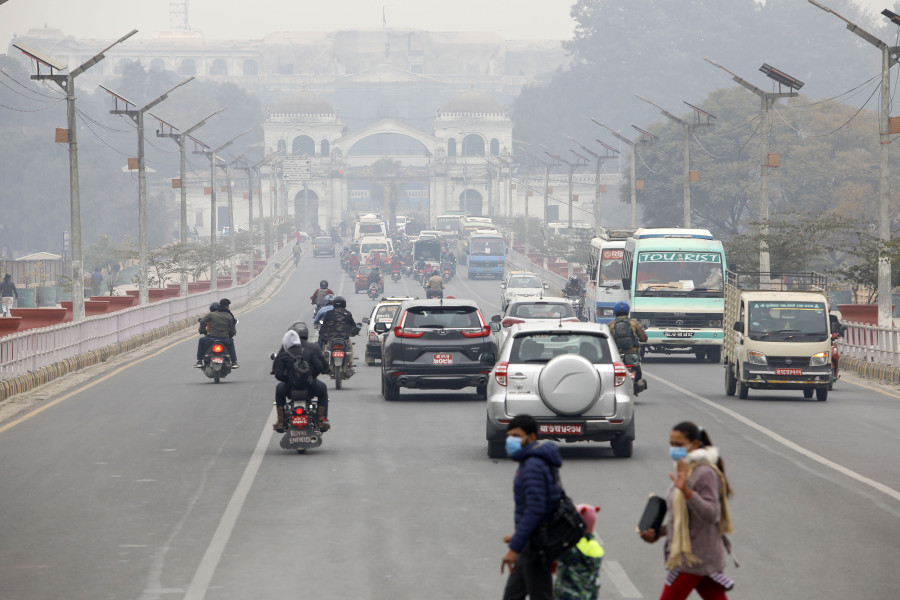Columns
Towards clean air in Nepal
Air pollution reduces productivity and degrades lifestyle with tangible economic consequences.
Faris Hadad-Zervos & Dina Umali-Deininger
Kathmandu was ranked the most polluted city in the world for several days in April 2023. On eight separate days of the month, daily average pollution levels of PM2.5—a particularly hazardous form of air pollution—exceeded 100 µg/m3—more than 6.5 times the World Health Organization’s 24-hour average guideline recommendation. Smoke from forest fires across the country, which rose by 76.5 percent as compared to the previous year—combined with transboundary smog and local emissions (from motor vehicles, cook stoves, industries, and waste burning)—choked Kathmandu and several parts of the country including the Terai region.
Air pollution is a public health crisis across Kathmandu Valley and the Tarai region, reducing the average life expectancy in Nepal by more than five years and causing significant cardiovascular and lung diseases. Such health effects are also reducing people’s productivity and degrading their quality of life with tangible economic consequences. The estimated negative welfare effects of air pollution in Nepal amount to more than six percent of the national GDP.
In 2021, Nepal adopted the Green, Resilient, and Inclusive Development (GRID) approach. As a next step, the country is currently developing the GRID Strategic Action Plan, and air pollution is a top priority here. The Government of Nepal’s ambitious climate commitments at COP26—to achieve net zero emissions by 2045 and increase the share of clean energy in the country's energy demand to 15 percent—are imperative and an excellent opportunity to beat air pollution in Nepal.
The key to effectively addressing air pollution is tackling the various sources and origins, including in other countries.
Finding synergies
While addressing the primary sources of air pollution, Nepal can find solutions that effectively tackle multiple sources, such as forest fires and brick kilns. To create a market for woody residues, which are the main input for the fledgling wood pellet industry in the country, one not only reduces the likelihood of forest fires (by removing the forest underbrush for use in pellets) but also creates a market and replacement for burning coal in brick kilns. Adopting a minimum coal price would be an important incentive for switching to pellet burning. Such a policy and minimum non-coal fuel requirements for brick kilns are currently being worked out in Nepal; the World Bank is supporting technical assessments to examine practical options for implementing such a policy.
Adopting cleaner technologies and practices can tackle the other key sources of air pollution, like using wood, dung and agricultural waste as fuel for residential cooking and urban mobility. The World Bank is supporting the adoption of cleaner technologies such as electric vehicles and electric cookstoves as part of the first GRID Development Policy Credit operation.
Working beyond borders
Clean air is a classic regional public goods case, owing to transboundary airflows, requiring collective action by the countries, cities and municipalities sharing the same airshed. The World Bank has a unique comparative advantage and role in addressing regional and global public goods challenges, as was emphasised recently in the Evolution Roadmap. Nepal is not alone in suffering from air pollution. Some of the air pollution that plagues Kathmandu originates from nearby countries, just as Nepal’s emissions contribute to air pollution further downwind. Both regional and subnational cooperation is critical to curbing air pollution.
As the recent World Bank report Striving for Clean Air—Air Pollution and Public Health in South Asia suggests, the solutions to air pollution challenges in the region require prioritising measures to achieve air quality benefits across the entire airshed. Recent efforts by Nepal and neighbouring countries bode well for regional coordination on effective policies. For example, the recently signed Kathmandu Roadmap demonstrates a clear demand for a regional platform to assess policies, paving the way for coordinated air quality planning and sharing implementation experiences.
However, successful responses require more than coordination and information sharing. The governments in the Indo-Gangetic Plain and Himalayan Foothills, including Nepal, must focus on the four areas to curb air pollution. First, incentives should be prioritised. Businesses will tend toward least-cost solutions, but if negative environmental impacts are not priced into that cost, wrong signals and perverse incentives can result in poor outcomes. Price signals can be set to incentivise clean technologies (for example, paying farmers and foresters to collect biomass for making pellets instead of burning it) while discouraging polluting ones (e.g., pricing coal to reflect its carbon content). Second, collecting and publicly disseminating data on pollution levels and building greater awareness of its impact on public health, the economy, and the environment is imperative. Better information enables conditions for evidence-based public policies that ensure regulations are fit for purpose.
Institutions play a primary role as air quality management planning is a complex, multi-sectoral process. It requires long-term, sustained efforts by ministries and agencies to collect and analyse data and work with stakeholders to identify and implement collective solutions that address concerns and achieve results. Along with clarifying roles and responsibilities, capacity building within the government and stronger partnerships with the private sector is necessary. Ultimately, investment in adopting innovative, clean technology is critical. Private sector finance is essential to get to scale. Concessional financing, in turn, is crucial in de-risking private sector investments in innovative clean technologies.
Nepal is working hard with its neighbours to achieve solutions that align with these four principles, helping in livelihood improvement, enhancement of the quality of life and public health preservation. The World Bank is committed to supporting Nepal and countries in the South Asia region to ensure the conditions for success are met.




 12.99°C Kathmandu
12.99°C Kathmandu














%20(1).jpg&w=300&height=200)

